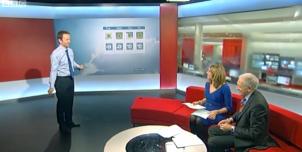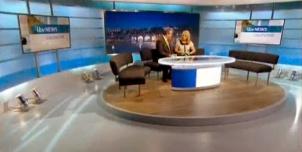Full Freeview on the Emley Moor (Kirklees, England) transmitter
| Google Streetview | Google map | Bing map | Google Earth | 53.611,-1.666 or 53°36'41"N 1°39'57"W | HD8 9TF |
The symbol shows the location of the Emley Moor (Kirklees, England) transmitter which serves 1,550,000 homes. The bright green areas shown where the signal from this transmitter is strong, dark green areas are poorer signals. Those parts shown in yellow may have interference on the same frequency from other masts.
_______
Digital television services are broadcast on a multiplexes (or Mux) where many stations occupy a single broadcast frequency, as shown below.
64QAM 8K 3/4 27.1Mb/s DVB-T MPEG2
DTG-12 QSPK 8K 3/4 8.0Mb/s DVB-T MPEG2
H/V: aerial position (horizontal or vertical)
Which Freeview channels does the Emley Moor transmitter broadcast?
If you have any kind of Freeview fault, follow this Freeview reset procedure first.Digital television services are broadcast on a multiplexes (or Mux) where many stations occupy a single broadcast frequency, as shown below.
64QAM 8K 3/4 27.1Mb/s DVB-T MPEG2
DTG-12 QSPK 8K 3/4 8.0Mb/s DVB-T MPEG2
H/V: aerial position (horizontal or vertical)
Which BBC and ITV regional news can I watch from the Emley Moor transmitter?

BBC Look North (Leeds) 1.9m homes 7.4%
from Leeds LS9 8AH, 22km north-northeast (22°)
to BBC Yorkshire region - 56 masts.

ITV Calendar 1.9m homes 7.4%
from Leeds LS3 1JS, 22km north-northeast (16°)
to ITV Yorkshire (Emley Moor) region - 59 masts.
All of lunch, weekend and 80% evening news is shared with Belmont region
Are there any self-help relays?
| Derwent B | Active deflector | 74 homes | |
| Derwent C | Active deflector | (second level) | |
| Dunford Bridge | Active deflector | 14 km S Huddersfield | 15 homes |
| Hmp Leeds | Transposer | 30 homes | |
| Thixendale | Transposer | 25 km ENE York | 40 homes |
How will the Emley Moor (Kirklees, England) transmission frequencies change over time?
| 1956-80s | 1984-97 | 1997-98 | 1998-2011 | 2011-13 | 5 Feb 2020 | ||||
| VHF | B E T | B E T | B E T | B E T | W T | ||||
| C10 | ITVwaves | ||||||||
| C32 | com7 | ||||||||
| C33 | SDN | ||||||||
| C34 | com8 | ||||||||
| C36 | ArqA | ||||||||
| C37 | C5waves | C5waves | |||||||
| C39 | _local | ||||||||
| C41 | C4waves | C4waves | C4waves | BBCB | BBCB | ||||
| C44 | BBC1waves | BBC1waves | BBC1waves | D3+4 | D3+4 | ||||
| C47 | ITVwaves | ITVwaves | ITVwaves | BBCA | BBCA | ||||
| C48 | ArqB | ArqB | |||||||
| C51tv_off | BBC2waves | BBC2waves | BBC2waves | SDN | |||||
| C52tv_off | ArqA | ||||||||
| C55tv_off | com7tv_off | ||||||||
| C56tv_off | LLS |
tv_off Being removed from Freeview (for 5G use) after November 2020 / June 2022 - more
Table shows multiplexes names see this article;
green background for transmission frequencies
Notes: + and - denote 166kHz offset; aerial group are shown as A B C/D E K W T
waves denotes analogue; digital switchover was 7 Sep 11 and 21 Sep 11.
How do the old analogue and currrent digital signal levels compare?
| Analogue 1-5 | 870kW | |
| SDN, ARQA, ARQB, BBCA, D3+4, BBCB | (-7dB) 174kW | |
| com7 | (-12dB) 54.8kW | |
| com8 | (-12.3dB) 51.2kW | |
| Mux 1*, Mux 2*, Mux B*, Mux C* | (-19.4dB) 10kW | |
| Mux A*, LLS | (-22.4dB) 5kW | |
| Mux D* | (-23.4dB) 4kW |
Which companies have run the Channel 3 services in the Emley Moor transmitter area
|
|
Friday, 14 June 2013
J
John Taylor8:04 PM
Bradford
Jonny reynolds:
You have lost Multiplex 2 by the sounds. I would be using the manual retune screen (UHF CH 44) to be checking the signal and taking things from there.
| link to this comment |
John's: mapJ's Freeview map terrainJ's terrain plot wavesJ's frequency data J's Freeview Detailed Coverage
Saturday, 15 June 2013
S
steve10:45 AM
Will the new 4g network using the 800mhz network effect freeview channels broadcast from the emley moor transmitter?
| link to this comment |
steve: I expect that there will be "some" people affected who use the Emley Moor transmitter.
| link to this comment |
S
steve12:24 PM
Hi Dave, Why only some? Does anyone know which ones for sure? I have just got a postcard offering a filter if affected.
| link to this comment |
steve: Because it won't be all who are affected.
Generally speaking, those potentially affected will be in small pockets where the 4G signal is strong and, relatively speaking, the TV signal is weak. This will tend to be those who are in close proximity to a 4G base station.
The issue will not be the presence of signals in the 800MHz per se, but where 4G signals are at much greater level than TV signals.
There are similarities with RF signals and light so consider what you know about the latter. Think of walking alongside a road at night. When car headlights come towards you they are bright and prevent you from seeing the darker surroundings that would otherwise be visible. The headlights are like the 4G signal in cases where TV reception may be affected.
The strength of a signal drops off rapidly as distance from a transmitter increases so those affected will usually be in close proximity to base stations.
There are a whole raft of other factors that act as fors and againsts as to the likelihood of an issue. These include the closeness of the frequencies of the wanted (TV) signal and the unwanted (4G) signal and the degree which the aerial is sensitive to each.
A wideband aerial, which is not necessary for TV from Emley Moor, is likely to be more sensitive on the 800MHz frequencies than one that isn't wideband, for example.
All in all there are so many variables that it is practically impossible to calculate whether any one individual is likely to be affected and with any degree of certainty.
If at800, which is the organisation sending out postcards, does not know for certain which viewers "will" be affected, who do you think might be more certain? If such people exist why do you think that at800 did not consult with them?
at800 have carried out a number of tests and it appears that a small minority will be likely to be affected:
Testing | at800
The newspapers are quick to report that a particular proportion of viewers are expected to be affected. They quote statistics such as more people will be affected who use Crystal Palace than any other transmitter. It is also a fact that more people use Crystal Palace than any other transmitter!
The question most people are interested in is one of whether they will be affected. That has so many unknowns that it is impossible to say. The newspapers don't bother to mention this though. A crystal ball would seem to be the only way one might get to know whether TV reception will be affected.
| link to this comment |
S
steve2:01 PM
Leeds
Thanks for that dave,I sense a bit of a con going on as the 4g operators said in the application for the frequencies that only 90,000 households out of the whole country would be affected, Now it seems no one knows till it is switched on how many it will effect, so how could they say only a very few people (90,000 housolds) will be affected in there licence submission
| link to this comment |
steve's: mapS's Freeview map terrainS's terrain plot wavesS's frequency data S's Freeview Detailed Coverage
steve: Just to add to Dave Lindsay's excellent description, it is my understanding that there were ZERO homes taken off air in London by the 4G tests.
The signal from Crystal Palace is just too strong - this means that homes were not using boosters.
The results from York and Brighton are more interesting, because in both of these places the Freeview signals before switchover were very low.
This meant that people were using MRD (Margin Raising Devices) aka Masthead Amplifiers.
It's the Masthead amplifiers that cause the 4G signal to overload the Freeview.
However, this has still been limited mainly to HIMO (Houses in Multiple Occupancy) where many homes share the same aerial.
This will boost the number of homes affected.
So, to answer the question about Emley Moor, the answer is almost 100% "no", because:
1) The signal is very high from the mast, almost all the way to the radio horizon.
2) The North of England has very few HIMO compared to somewhere like Brighton.
3) MRDs are less common because the Freeview signals were OK before switchover.
4) People who are in fringe signal areas for Emley Moor can and do use other transmitters (Pontop Pike in the north, Waltham to the south).
But it must be said again, you can't say be Freeview Mast where the problems will be it depends on the use of MRDs.
| link to this comment |
steve: "4g operators said in the application for the frequencies that only 90,000 households out of the whole country would be affected".
Not true. Ofcom said the figures would be
Of the 16.3 million UK homes with a standard (unamplified, unshared) Freeview reception, 110,000 (0.67%) would be effected.
Of the 5.2 million homes using communal aerials systems, 550,000 (10.6%) will have problems.
Of the 5.6 million homes using amplified Freeview reception, 100,000 (1.8%) will experience problems.
Ofcom moves to protect Freeview interference from 4G mobile devices | 4G-at-800 | ukfree.tv - 10 years of independent, free digital TV advice
"Now it seems no one knows till it is switched on how many it will effect, so how could they say only a very few people (90,000 housolds) will be affected in there licence submission"
Because they ran FOUR tests - London (South East and West), Brighton and Hove and York Expecting 4G interference? Tests now show that you have a one in 300 chance | 4G-at-800 | ukfree.tv - 10 years of independent, free digital TV advice
| link to this comment |
steve: Just to clarify, I mean that the 4G bids were done on the basis of the Ofcom figures.
| link to this comment |
Dave Lindsay: As far as I know, the use of Wideband aerials makes no difference.
I will look into this, but we won't know for sure until at800 publish the trail results in full.
| link to this comment |
Select more comments
Your comment please!





